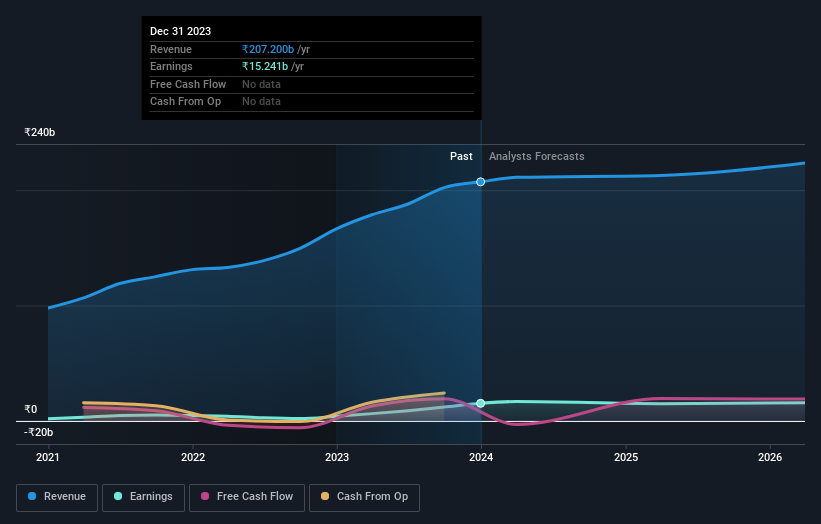- India
- /
- Metals and Mining
- /
- NSEI:JINDALSAW
Results: Jindal Saw Limited Beat Earnings Expectations And Analysts Now Have New Forecasts

Jindal Saw Limited (NSE:JINDALSAW) defied analyst predictions to release its third-quarter results, which were ahead of market expectations. The company beat forecasts, with revenue of ₹57b, some 5.7% above estimates, and statutory earnings per share (EPS) coming in at ₹16.72, 51% ahead of expectations. Earnings are an important time for investors, as they can track a company's performance, look at what the analysts are forecasting for next year, and see if there's been a change in sentiment towards the company. We thought readers would find it interesting to see the analysts latest (statutory) post-earnings forecasts for next year.
View our latest analysis for Jindal Saw

Taking into account the latest results, the consensus forecast from Jindal Saw's dual analysts is for revenues of ₹212.8b in 2025. This reflects a satisfactory 2.7% improvement in revenue compared to the last 12 months. Statutory earnings per share are forecast to shrink 2.6% to ₹46.75 in the same period. Yet prior to the latest earnings, the analysts had been anticipated revenues of ₹202.0b and earnings per share (EPS) of ₹35.90 in 2025. So it seems there's been a definite increase in optimism about Jindal Saw's future following the latest results, with a great increase in the earnings per share forecasts in particular.
With these upgrades, we're not surprised to see that the analysts have lifted their price target 27% to ₹591per share.
These estimates are interesting, but it can be useful to paint some more broad strokes when seeing how forecasts compare, both to the Jindal Saw's past performance and to peers in the same industry. It's pretty clear that there is an expectation that Jindal Saw's revenue growth will slow down substantially, with revenues to the end of 2025 expected to display 2.1% growth on an annualised basis. This is compared to a historical growth rate of 14% over the past five years. Compare this against other companies (with analyst forecasts) in the industry, which are in aggregate expected to see revenue growth of 8.1% annually. So it's pretty clear that, while revenue growth is expected to slow down, the wider industry is also expected to grow faster than Jindal Saw.
The Bottom Line
The biggest takeaway for us is the consensus earnings per share upgrade, which suggests a clear improvement in sentiment around Jindal Saw's earnings potential next year. They also upgraded their revenue estimates for next year, even though it is expected to grow slower than the wider industry. There was also a nice increase in the price target, with the analysts clearly feeling that the intrinsic value of the business is improving.
Following on from that line of thought, we think that the long-term prospects of the business are much more relevant than next year's earnings. At least one analyst has provided forecasts out to 2026, which can be seen for free on our platform here.
Plus, you should also learn about the 2 warning signs we've spotted with Jindal Saw (including 1 which doesn't sit too well with us) .
New: Manage All Your Stock Portfolios in One Place
We've created the ultimate portfolio companion for stock investors, and it's free.
• Connect an unlimited number of Portfolios and see your total in one currency
• Be alerted to new Warning Signs or Risks via email or mobile
• Track the Fair Value of your stocks
Have feedback on this article? Concerned about the content? Get in touch with us directly. Alternatively, email editorial-team (at) simplywallst.com.
This article by Simply Wall St is general in nature. We provide commentary based on historical data and analyst forecasts only using an unbiased methodology and our articles are not intended to be financial advice. It does not constitute a recommendation to buy or sell any stock, and does not take account of your objectives, or your financial situation. We aim to bring you long-term focused analysis driven by fundamental data. Note that our analysis may not factor in the latest price-sensitive company announcements or qualitative material. Simply Wall St has no position in any stocks mentioned.
About NSEI:JINDALSAW
Jindal Saw
Engages in the manufacture and supply of iron and steel pipes and pellets in India and internationally.
Undervalued with excellent balance sheet and pays a dividend.
Similar Companies
Market Insights
Community Narratives



